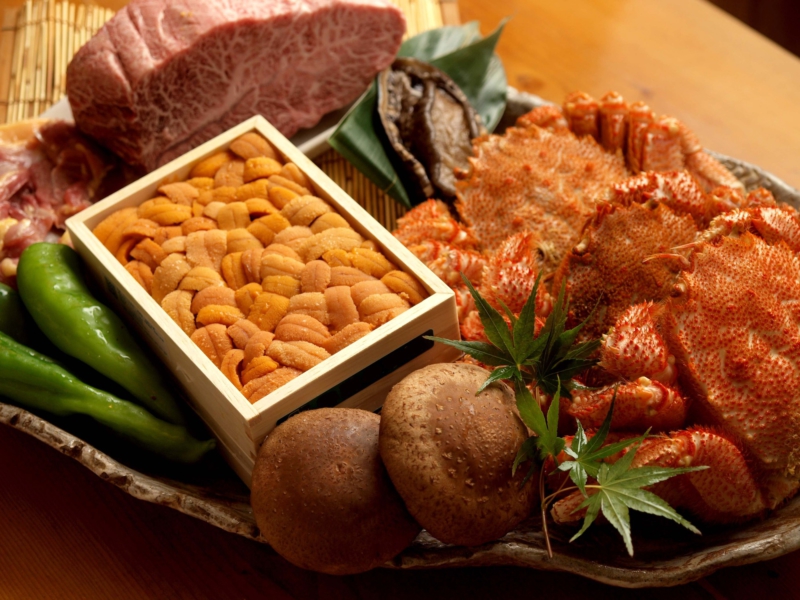What if we told you that for as little as 2,000 yen, you can get meat, rice, seasonal fruit, and other regional specialties from all over Japan while also paying less in taxes? That’s what the Hometown Tax program offers, and if you’re a foreigner residing in Japan, it would be a waste to not take advantage of it! More importantly, though, the Hometown Tax also helps to revitalize regions hit by natural disasters, and you don’t need to live in those areas in order to help them out. In this article, we’ll discuss how the Hometown Tax operates and how you can apply for it, and once you know that, you’ll be able to reap all of the benefits of the program as soon as possible.
Table of Contents
- What is the Hometown Tax? (Foreigners Can Use It Too!)
- The Pros and Cons of the Hometown Tax Program
- Don’t Know What to Choose? Try These Popular Gifts!
- How the Hometown Tax Program Looks Like, From the Application to When Your Gift Arrives
- Use the One-Stop Special System to Claim a Donation Deduction Without a Final Income Tax Return!
- Recommended Hometown Tax Websites
What is the Hometown Tax? (Foreigners Can Use It Too!)

Originally, the Hometown Tax was envisioned as a system for people to divert part of their taxes to their home regions after they move to bigger cities like Tokyo for school or work, as a way to help revitalize the local economy. Taxpayers can choose where exactly the tax should go, so they can be used to help out areas hit by natural disasters like earthquakes or typhoons, or to places that need an economic boost. Note: you cannot donate money to where you’re currently living.
So far, all of this must sound like regular tax payment mixed with charitable donations. But what makes the Hometown Tax special is that once you donate money through it, not only will you be able to deduct the sum from your owed tax amount, you’ll also be sent a local specialty from the region you donated to as thanks. We will now discuss the pros and cons of foreigners making use of the Hometown Tax program.
The Pros and Cons of the Hometown Tax Program

◎Pro #1
As mentioned before, not only will you be able to deduct your contributions from your taxes, you’ll also get a gift in return like seafood, meat, vegetables, rice, and other local specialties from regions all over Japan. Many of the Hometown Tax presents are famous delicacies, so if there’s some food you really wanted to try, simply donate to the region where it comes from.
◎Pro #2
You have to pay taxes anyway, so why not also get a present out of it? For example, if you donate 30,000 yen and make use of the One-Stop Special System (discussed later), your resident tax for next year will be 28,000 yen smaller (as the amount is calculated by subtracting 2,000 yen from your contribution). In the end, the amount you have to pay in taxes won’t really change, but you’ll also get a gift.
◎Pro #3
You can get additional presents, depending on which site you use when signing up for the Hometown Tax. There are a lot to choose from. By using, for example, Rakuten’s or Yahoo’s site, you might also get special gifts or points that can be used with those services. Look for Hometown Tax websites connected to your credit card or to an online shop you frequent to get the best deal possible.
◎Pro #4
You get to choose where your money actually goes to. When donating to the Hometown Tax program, you can specify that you want your contributions to go to “creating childcare facilities and opportunities” or “healthcare and welfare” or “preserving nature.”
✖ Con #1
If any of the following three conditions apply to you, you’ll need to file a final income tax return:
• You’ve donated to six or more municipalities in a single year.
• You did not apply for the One-Stop Special System (discussed later).
• You’re a salaried employee with substantial medical expenses who files returns for medical deductions.
A final income tax return calculates all of your income and applicable taxes in a given year. It’s filed by individual business proprietors and freelancers, but if any of the aforementioned three conditions apply to you, then it doesn’t matter if you’re a salaried employee; you’ll have to file a final income tax return. Those who normally file final income tax returns have to file one with information on their Hometown Tax contributions, even if they’re donated to fewer than six jurisdictions. When filing these returns, you’ll need to also submit your donation receipt certificate that you’ve gotten from the municipality you donated to.
The proper time to file a final income tax return differs depending on the municipality, so find out when your deadline is. For information on how to fill out an income tax return, consult the appropriate window at your local city/ward office or at the official website. You can also create your tax return at the tax office and file it there.
✖ Con #2
If you go over your maximum tax deduction amount, you’ll have to pay money out of your own pocket. While you’re within that limit, you can think of the Hometown Tax program as “buying a wonderful gift with just 2,000 yen,” which is a win for you, but if you go over your deduction, it’s more like “paying a lot of money for one gift,” which sounds more like a loss, so please be careful.
Your maximum tax deduction amount depends on your income and the number of your dependents. There are sites that will help you calculate it, but it will just be a ballpark figure, because that amount changes depending on the kind of income you’re getting, your marital status, bereavement, and other factors. So before you donate money to the Hometown Tax program, try to calculate how much you can deduct from your taxes, and go with a jurisdiction that will send you a gift without putting you over your deduction limit.
Don’t Know What to Choose? Try These Popular Gifts!
When you look at websites listing all the local specialties available as Hometown Tax gifts, you’ll quickly see that there are so many of them that it’s easy to get overwhelmed. That’s why we’ve prepared a list of our recommended gifts divided into three categories: Meat, Seafood, and Fruit.
◆Meat
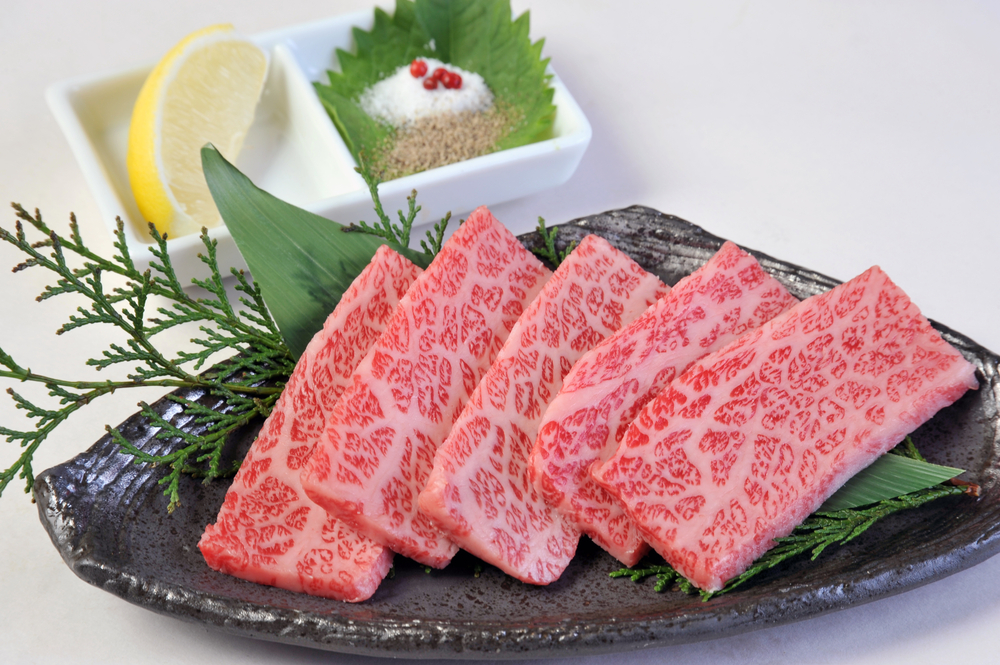
Besides beef, pork, and chicken, horse meat and processed meats such as ham and sausages are also available.
Beef
You can choose “Kobe Beef,” the famous high-grade beef variety popular among foreign tourists, as a Hometown Tax gift. You can use it to make sukiyaki (thin slices of beef cooked with various vegetables) or Kobe beef steaks, but we recommend you grill it yakiniku style. The Kobe beef pieces are 5mm in thickness, so they can be easily prepared in a regular pan on a household stove. Then simply sprinkle them with salt and pepper and enjoy! If you’d also like to help a jurisdiction hit by natural disasters, choose Kumamoto Prefecture, which experienced devastating torrential rains in July 2020, and get their famous Kumamoto Akaushi beef in return.
Chicken
We recommend Hinai chicken, one of the Big Three regional Japanese chicken varieties, which is characterized by its rich taste and soft texture even after it’s cooked. You can use the thigh meat to make delicious chicken saute, but we would like you to consider preparing it in a hot pot with kiritanpo (toasted mashed rice on skewers), a local specialty in Akita Prefecture where the Hinai chickens come from. First, boil the meat with vegetables like Chinese cabbage or spring onions (though you can use any vegetable you like), then add the kiritanpo for a delicious hot pot feast that you won’t soon forget.
◆Seafood
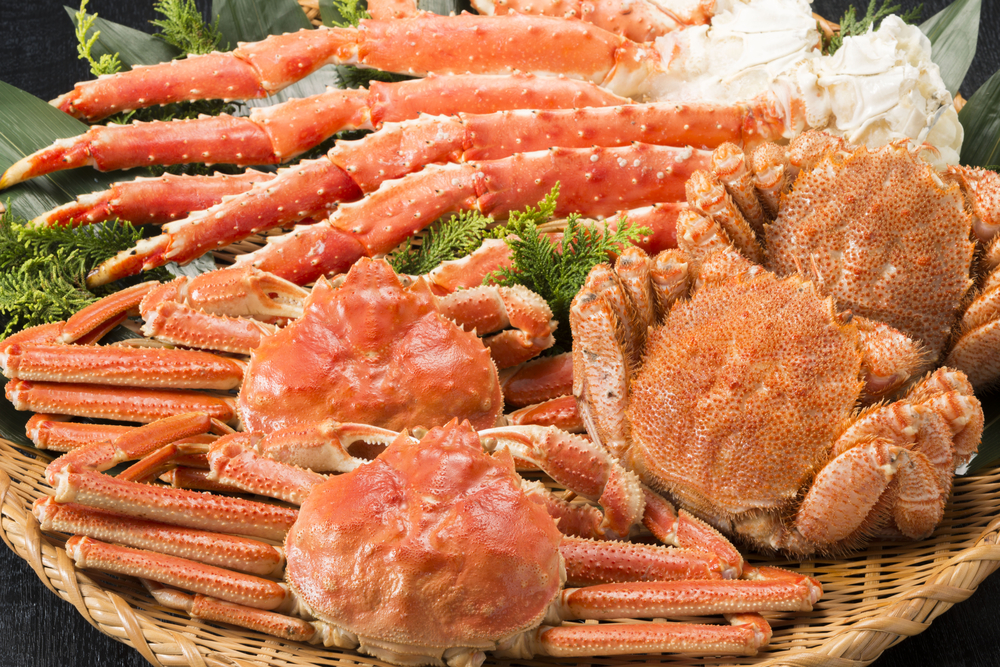
Hometown Tax seafood gifts include high-quality items like crab, sea urchin, and salmon roe, as well as everyday Japanese products like dried fish sets. If you’re not used to Japanese food, we recommend you go with salmon.
Tuna
When talking about fine Japanese food, you have to mention that staple sushi topping: tuna sashimi. The Hometown Tax tuna gifts come frozen, which makes them easier to cut, and many of them are already skinned and deboned, leaving just blocks of delicious tuna meat. That style of tuna is called “saku,” and it can be easily cut with a household knife, so that anyone can enjoy fresh sashimi in the comfort of their own home.
Crab
Crab is also a popular Hometown Tax gift. It can be sashimi-grade raw or boiled and frozen. If you want to taste real Japanese crab, you should definitely consider donating to a region that’s known for their crabs. However, keep in mind that some areas that accept Hometown Taxes and process crab meat actually import the original crabs from Canada or Russia. Some Japanese people also enjoy crab innards and eggs, but if you’re just after the meat, you should order gifts of just crab legs and claws, which are much easier to eat.
◆Fruit

Strawberries
We recommend Fukuoka Prefecture’s famous Amaou strawberries, which are the definition of luxury, on account of their incredibly sweet taste and their size, with one Amaou strawberry being 5-6cm big.
Grapes
Large and sweet grape varieties like Shine Muscat, Pione, and Kyoho are popular gift choices. They grow in prefectures including Okayama, Nagano, Yamanashi, and Yamagata.
How the Hometown Tax Program Looks Like, From the Application to When Your Gift Arrives
① Go on a web portal that helps you calculate your maximum tax deduction limit
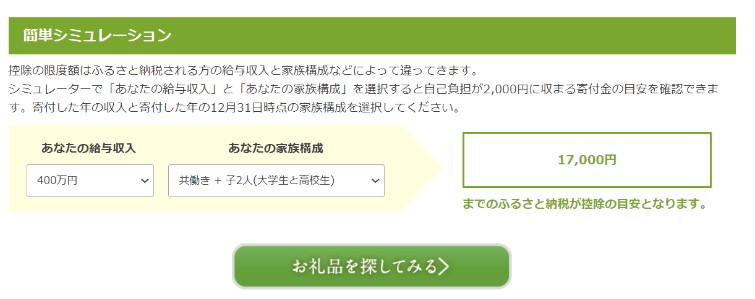
② Order a gift you like from this web portal
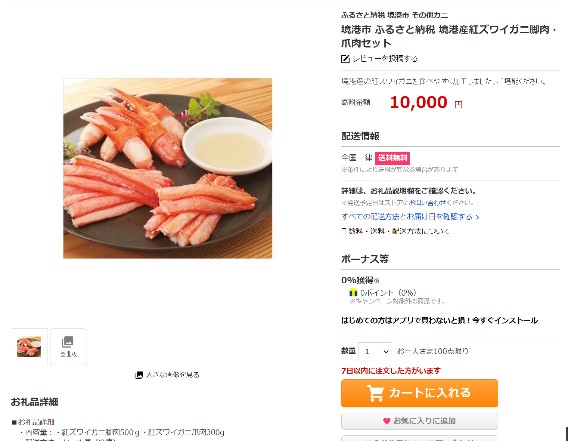
③ Receive your gift
④ Save your receipt
If you’re using the One-Stop Special System (discussed later), you’ll need to save your receipt and One-Stop Special application form. The One-Stop Special application form can be downloaded from many web portals. In some cases, you can also obtain it by mail from the relevant municipality. Your receipt will arrive at different times depending on the municipality, but the following three situations are most common:
- The receipt will be included with your Hometown Tax gift.
- Your receipt will be mailed to you separately about 1-2 months after your donation.
- Your receipt will be mailed to you together with a statement of all your contributions from the past year. It should arrive no later than mid-February of the year you file your final income tax return.
⑤ Claim your tax deduction
If you’re not using the One-Stop Special System, simply file your final income tax return with your Hometown Tax receipt attached. This return calculates your final income after all of your expenses have been subtracted from the money you’ve earned between January 1 and December 31. All of those calculations (revenue, expenses, deductions, income) are written on the final income tax return, which is filed at your local tax office between February 16 and March 15.
There are two things you should be mindful of when it comes to tax deductions:
- The person claiming the deduction has to apply for them. For example, if a wife applies for a deduction under her name, then her husband cannot claim it on his taxes.
- The information you’ve used to order a Hometown Tax gift has to be the same as on your certificate of residence. Your receipt will feature the information you provided when signing up for a gift, and if that information differs from your certificate of residence, you won’t be able to claim a deduction.
Use the One-Stop Special System to Claim a Donation Deduction Without a Final Income Tax Return!
If you fulfill the following two conditions, you can claim a donation deduction on your taxes without filing a final income tax return. It’s called the One-Stop Special System.
• You don’t normally file a final income tax return (i.e. are a salaried employee or a public servant).
• You donated to no more than five municipalities between January 1 and December 31. (You still fulfil this condition even if you, for example, donated seven times to the same municipality).
◆How to Apply
① What you’ll need
• A One-Stop Special System application form (available through a number of websites).
• A form of ID. Any of the following is acceptable:
A) A copy of the front and the back of your My Number card.
B) A copy of your My Number notification or of your certificate of residence that includes your personal number + a copy of your driver’s license or of your passport.
C) A copy of your My Number notification or of your certificate of residence that includes your personal number + copies of at least two documents accepted by the accepting municipality as valid forms of ID, like your health insurance card or your pension book.
② Fill out the application form
▼Application Form
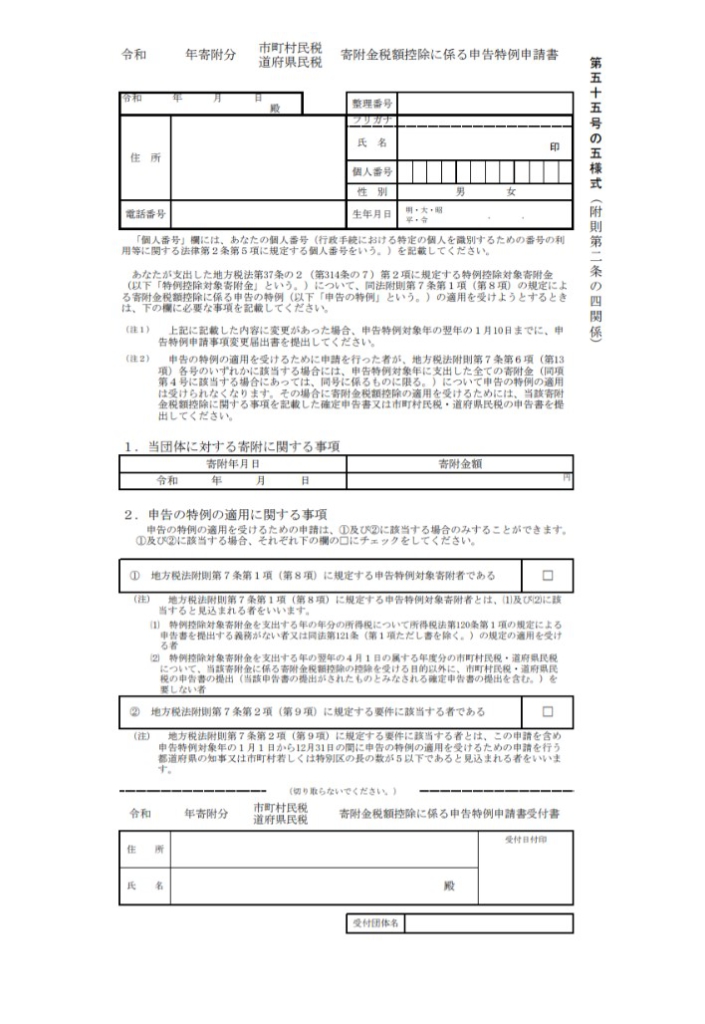
③ Mail all of the above to the Hometown Tax municipality you donated to so that it arrives before January 10 the following year
Recommended Hometown Tax Websites
Different web portals list different Hometown Tax jurisdictions and special gifts. You should compare them to find a gift connected to a credit card you normally use or a site you frequently shop at. It might be a bit difficult, since no Hometown Tax site offers multilingual support, but the deals you can get are more than worth it.
▼Furusato Choice: https://www.furusato-tax.jp/about
▼Satofull: https://www.satofull.jp/static/instruction01.php
▼Yahoo! Satofull: https://shopping.geocities.jp/y-sf/
▼Furunavi: https://furunavi.jp/
▼Rakuten Furusato Nozei: https://event.rakuten.co.jp/furusato/
If you don’t think that the Hometown Tax is worth it, consider that you already have to pay taxes to your local municipality. And if you’ll be spending that amount of money anyway, why not challenge yourself this year and participate in the Hometown Tax program? For just 2,000 yen, you’ll be able to get local specialties from regions all over Japan. That’s a pretty great deal, so give it a try!
* Thumbnail: PIXTA
If you want to give feedback on any of our articles, you have an idea that you’d really like to see come to life, or you just have a question on Japan, hit us up on our Facebook!
The information in this article is accurate at the time of publication.
